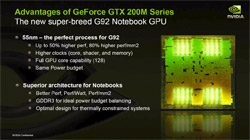NVIDIA Intros GeForce GTX 200M and GTS 100M GPUs
The new GeForce GTX and GTS series of notebook GPUs utilize a refined 55nm variant of NVIDIA's G92 graphics core optimized for lower power consumption. According to the information provided by NVIDIA, the GPU provides up to 80% higher perf/mm2 than the previous gen, in addition to higher core, shader, and memory clock frequencies, and in the case of the GTX 280M a full complement of 128 shader processors. The GTX 260M and GTS 160M are outfitted with fewer active shader cores.
The GeForce GTX 280M and GTX 260M will be targeted at the enthusiast / gamer segment of the market and will be utilized in higher performing, larger sized DTR and gaming notebooks. The GTS 260M will be targeted at more mainstream, and more affordable market segments, and be used in smaller, lighter notebooks.
In addition to operating in single GPU configurations, these GPUs also support NVIDIA's SLI multi-GPU technology and will be offered in dual-GPU configurations in select notebooks. They will also be compatible with NVIDIA's recently released mobile GeForce drivers, which means users won't be constrained by slow-to-update notebook manufactures, who rarely released updated mobile graphics drivers. This is an important consideration to maintain maximum performance and compatibility throughout the product's lifetime.

The specifications and features of the new GeForce GTX 200M and GTS 100M series mobile GPUs are listed in the table above. As we've mentioned, the GTX 280M features a full 128 shaders cores. The GTX 260M, however, features 112 and the GTS 160M 64. All of them feature 256-bit memory interfaces, however, and support for frame buffers up to 1GB.
We expect NVIDIA to announce some design wins for all of these new mobile GPUs in the not too distant future.








